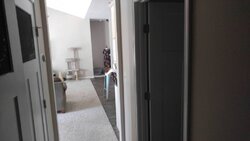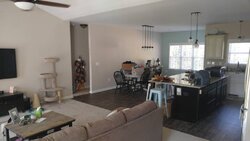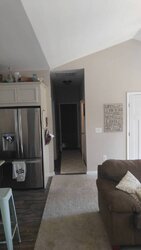Does anyone leave the fan on the ac unit on all the time to help pull heat in other rooms or just ceiling fans in reverse?
Leaving fan on for circulation?
- Thread starter Sanborn281
- Start date
-
Active since 1995, Hearth.com is THE place on the internet for free information and advice about wood stoves, pellet stoves and other energy saving equipment.
We strive to provide opinions, articles, discussions and history related to Hearth Products and in a more general sense, energy issues.
We promote the EFFICIENT, RESPONSIBLE, CLEAN and SAFE use of all fuels, whether renewable or fossil.
You are using an out of date browser. It may not display this or other websites correctly.
You should upgrade or use an alternative browser.
You should upgrade or use an alternative browser.
- Status
- Not open for further replies.
Bioburner
Moderator
Does just the fan draw much current? I would think not due to it not being a resistance heater or lightYes, many conversations on trying to get heat distributed
Sent from my VS990 using Tapatalk
Bioburner
Moderator
Some older systems are made with less economical fans. Newer systems may have a variable speed with DC motors. Members have everything from older dino burning furnaces to newer heat pumps with weather matching tech and remote phone controls.
Lake Girl
Moderator
Find out the specs on your AC unit ... What kind of layout on your home and where is the stove?
Many just turn them on intermittently to circulate air, some use fans. Like Bioburner mentioned, depends on what you have available and how your house is set up. Central stairways or open concepts tend to need less help with convection loop.
Many just turn them on intermittently to circulate air, some use fans. Like Bioburner mentioned, depends on what you have available and how your house is set up. Central stairways or open concepts tend to need less help with convection loop.
It's a new build so the ac/heat pump is variable speed so I'm assuming efficiency is good lol.. Who knowsFind out the specs on your AC unit ... What kind of layout on your home and where is the stove?
Many just turn them on intermittently to circulate air, some use fans. Like Bioburner mentioned, depends on what you have available and how your house is set up. Central stairways or open concepts tend to need less help with convection loop.
Master is door on right in hallway... Cat tower will be stove



I think the heat will go straight down hallway.. Behind cat tower is 2 spares and jack and Jill.thinking reverse fans will pull heat that way too
Sent from my VS990 using Tapatalk
Lake Girl
Moderator
Master bedroom should be no problem as it is a direct line. Not sure how you would get heat to the spares, J&J so that may be an experiment. On slab construction, basement? Just wondering on the plumbing for the J&J...
heat seeker
Minister of Fire
Doesn't work for me - the air handler is in the attic, and gets really cold. So, the heated air gets cooled a lot, which ends up chilling the house. Yes, it's insulated, but apparently not well enough for this use.
Basement construction. 9ft ceilingsMaster bedroom should be no problem as it is a direct line. Not sure how you would get heat to the spares, J&J so that may be an experiment. On slab construction, basement? Just wondering on the plumbing for the J&J...
Sent from my VS990 using Tapatalk
Lake Girl
Moderator
Thanks for the info ... not sure where Sanborn's unit is located.Doesn't work for me - the air handler is in the attic, and gets really cold. So, the heated air gets cooled a lot, which ends up chilling the house. Yes, it's insulated, but apparently not well enough for this use.
I'm in king George va.. Mines in the basement... I'm thinking all fans in room on reverse will be fine...Thanks for the info ... not sure where Sanborn's unit is located.
Sent from my VS990 using Tapatalk
Lake Girl
Moderator
Sometimes the convection loop works opposite of what you think A fan on the floor blowing cold air from those rooms towards the stove often is more effective. Flagging tape streamers on the walls with painter's tape will give you a visual on the convection loop...
A fan on the floor blowing cold air from those rooms towards the stove often is more effective. Flagging tape streamers on the walls with painter's tape will give you a visual on the convection loop...
edited for clarity...
 A fan on the floor blowing cold air from those rooms towards the stove often is more effective. Flagging tape streamers on the walls with painter's tape will give you a visual on the convection loop...
A fan on the floor blowing cold air from those rooms towards the stove often is more effective. Flagging tape streamers on the walls with painter's tape will give you a visual on the convection loop...edited for clarity...
Last edited:
railfanron
Minister of Fire
Yes heat seeker is right if it's in the attic. The temperature of the air is so low that even if insulated well it won't work as the low temp will usually drop a degree and the result is cooling the house instead of warming it. My duct has r5 duct wrap on it and it's then covered with r 38 insulation batts and it still doesn't work.
Ron
Ron
Lake Girl
Moderator
Added to my post above ... if a fan is placed on the floor drawing the colder air at floor level from those rooms and pushing towards the stove, you will promote the movement of warmer air into those rooms. Where is your cold air return located for AC?
adayrider
Member
Lake Girl is right, I tried for a year and a half trying to push warm air with a fan on the floor and didn't work. Then one cold winter day a light bulb went off, turn fan around on floor and faced toward the stove and it worked like a charm. Only bad thing is you have to walk around the fan.
RetiredSailor
New Member
Just installed a new Jotul F 400 wood burner and made sure to move the house thermostat out of the room it was placed in. Currently with the 45 to 50 degree temps outside, I throw a couple of logs in the stove then ensure the furnace fan is on. It is a Rheem high efficiency furnace (New York). We have a 1560 sq. ft. two story w/basement and I noticed the thermostat located on the other side of the house is around 69 to 72, just above the setting of 68. This is our first winter with this stove and it is only to provide supplemental heat and provide a nice fire to look at. Also comes in handy if we ever lose power. In the past, I left the power on to the furnace fan because this was one of the selling points; to remove cold spots in the house during the colder months. We have a very large cold air return about 8 feet from the stove, so it helps to suck in the warm air and distribute it around the house. The upstairs is colder but not by much, say around 66 to 68 or so; good enough for sleeping. In the morning, the thermostat may or may not have kicked in even with the two measly logs I put on the night before. So yes, I'm using electricity for moving the warm stove air around the house but using almost no gas to heat with. The multi-stage high efficiency furnace fan never kicks in to a higher speed since the thermostat never kicks in. Have fun.
I have r59 attic insulation. I'll try the fan against the stove. I haven't even installed stove yet. But next weekend
Sent from my VS990 using Tapatalk
Sent from my VS990 using Tapatalk
reallyte
Feeling the Heat
Tried air circulation but my unfinished cold basement dwelling furnace just made the air colder. Really is case by case dependent.
Wilbur Feral
Minister of Fire
There are two additional, often overlooked factors to consider when using HVAC system ducts to move pellet / wood stove heat:
1) How much heat loss will occur from lack of insulation around ducts running through unconditioned space?
2) How much heat loss will occur from leaks in the ductwork?
Prior to last two years, our ductwork in a late 70's contemporary with heat pump were showing almost 30% loss when measured with a pressure test. Just stupidly poor workmanship when house was built, long before we owned it. We ended up ripping out a garage ceiling to access at least a good portion of the ductwork, repairing and resealing more loose ducts than you could imagine, and then (primarily to air seal the garage from the family room above) giving it all a good coating of closed cell spray foam. Had earlier tried to seal from within using that technology (Google it), which would have worked well had we done the other duct sealing first (which that contractor should have checked for and recommended, but that's what happens when they just send out a salesman and don't first do a pressure test. This all cost thousands of dollars, but was necessary to minimize AC problems, which can't be solved with a pellet stove and were costing us much in energy (and made portions of house unusable in summer). But in the end, it solved our problems and effect on heating was equally dramatic, with significant drop in energy used in any form (heat pump for AC or heat, pellets, etc.).
And, for first time ever, turning on HVAC fan just to circulate heat around house actually seems to help. With leaky ducts, it was worthless if not downright negative.
1) How much heat loss will occur from lack of insulation around ducts running through unconditioned space?
2) How much heat loss will occur from leaks in the ductwork?
Prior to last two years, our ductwork in a late 70's contemporary with heat pump were showing almost 30% loss when measured with a pressure test. Just stupidly poor workmanship when house was built, long before we owned it. We ended up ripping out a garage ceiling to access at least a good portion of the ductwork, repairing and resealing more loose ducts than you could imagine, and then (primarily to air seal the garage from the family room above) giving it all a good coating of closed cell spray foam. Had earlier tried to seal from within using that technology (Google it), which would have worked well had we done the other duct sealing first (which that contractor should have checked for and recommended, but that's what happens when they just send out a salesman and don't first do a pressure test. This all cost thousands of dollars, but was necessary to minimize AC problems, which can't be solved with a pellet stove and were costing us much in energy (and made portions of house unusable in summer). But in the end, it solved our problems and effect on heating was equally dramatic, with significant drop in energy used in any form (heat pump for AC or heat, pellets, etc.).
And, for first time ever, turning on HVAC fan just to circulate heat around house actually seems to help. With leaky ducts, it was worthless if not downright negative.
Last edited:
womaus
Feeling the Heat
Master is door on right in hallway... Cat tower will be stove
View attachment 186122
I see nobody has mentioned that that cat is going to be very upset...be sure to close the hopper, he/she may try to get back at you.
Lmao the cat is getting a new tower in other side of roomI see nobody has mentioned that that cat is going to be very upset...be sure to close the hopper, he/she may try to get back at you.
Sent from my VS990 using Tapatalk
Phoenix Hatchling
Minister of Fire
We have 8 inch thick insulation surrounding the vent ducts. Minimal loss any works wonders balancing out heat to farther reaches.
- Status
- Not open for further replies.
Similar threads
- Replies
- 23
- Views
- 993
- Replies
- 0
- Views
- 136
- Replies
- 6
- Views
- 793
- Replies
- 2
- Views
- 523

